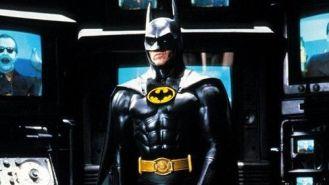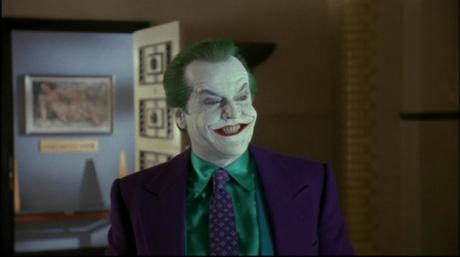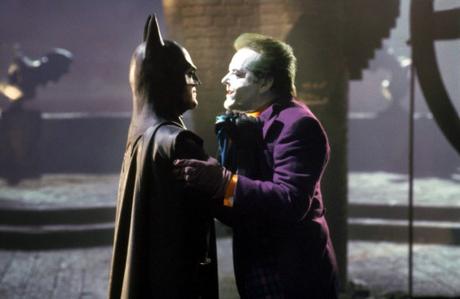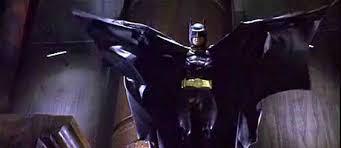Retro Review: 'Batman'
 By the time the 80's were coming to a close a host of gifted comic book creators had purged Batman of the campy elements associated with the 60's TV show and returned him to his dark roots. Thanks to the works of: Denny O'Neil, Neal Adams, Frank Miller, Steve Englehart, Marshall Rogers, and many others, Batman was once again the Dark Knight. Unfortunately for the mass populace the campy and comedic tone of the Adam West series is still how they saw the character. But one movie released in 1989 changed the way this character has been perceived in pop culture ever since. In 1989 the Caped Crusader became the first superhero since Superman to receive a big budget, theater release with the classic movie, Batman.
By the time the 80's were coming to a close a host of gifted comic book creators had purged Batman of the campy elements associated with the 60's TV show and returned him to his dark roots. Thanks to the works of: Denny O'Neil, Neal Adams, Frank Miller, Steve Englehart, Marshall Rogers, and many others, Batman was once again the Dark Knight. Unfortunately for the mass populace the campy and comedic tone of the Adam West series is still how they saw the character. But one movie released in 1989 changed the way this character has been perceived in pop culture ever since. In 1989 the Caped Crusader became the first superhero since Superman to receive a big budget, theater release with the classic movie, Batman.
Producer Bob Uslan had been trying for several years to bring his favorite comic book

The story was a fairly simple one, in the grim and art-deco inspired Gotham City a vigilante is looming around fighting crime dressed as a bat. This has attracted the attention of photographer Vicki Vale who helps, reporter Alexander Knox get to the bottom of this mystery. As expected her time in the city involves falling in love with a certain wealthy playboy, Bruce Wayne. Batman's quest to fight crime becomes a lot more difficult when a new villain, the Joker emerges with a desire to wreak havoc on the city. Inevitably the Dark Knight and the Clowned Prince of Crime must do battle for the future of Gotham City.
In a move which would surprise audiences of modern superhero, Batman skips the origin of the character, knowing he is iconic enough that people already know who he is. In fact the story of the Waynes being gunned down in Crime Alley leaving a traumatized Bruce Wayne orphaned unfolds as a side plot, which adds to the mysterious nature of Batman in the narrative. Taking an interesting liberty, the movie changes the gunman into a young Joker which adds another layer to the rivalry between the two characters.

Easily the most controversial decision during the production of this movie was eschewing a chiseled, square-jawed, leading man like Alec Baldwin, Rob Lowe, or Pierce Bronsan. Instead Burton cast a comedic actor of short stature, Michael Keaton to don the black suit. Understandably fans railed against this casting at first, but once Batman was released, Keaton silenced all critics. What he lacked physically in the role he more than made up for with his intensity. Keaton's Dark Knight was a hero who stalked the shadows of Gotham like a man possessed. This makes Nicholson's Joker the perfect foil, we all know Jack Nicholson could play crazy and Tim Burton famously let the legendary actor off his leash with the creative freedom to make the infamous villain his own. Caught in the war between these two outlandish characters is Kim Basinger as photojournalist Vickie Vale. More than just a damsel in distress her character is calm and collected in the fact of the Joker's unpredictable machinations. Of course Tim Burton populated the rest of Gotham City with a host of gifted actors in supporting roles, like Michael Gough and Pat Hingle as Alfred and Commissioner Gordon, two roles they would remain in throughout this run of movies. Billy Dee Williams joined the production as DA Harvey Dent, unfortunately the studio bought him out of his contract and he would not come back to play Two Face. Stealing every scene he is in is comedian Robert Wuhl as a reporter trying to uncover the truth about the mysterious Batman with a no shortage of sarcasm and wit.
Taking visual influences from early comics and pulp adventures, the Gotham City

Since Batman was released, the Caped Crusader has become a mainstay of cinema starring in a multitude of movies but it all started here. Tim Burton proved to everyone that a darker and more serious take on Batman could work with mass audiences. And after so many different takes on the character's mythos on the big screen this film still holds up. Sure it may be a bit campier than it was seen in 1989, but it is still an exciting flick and the performances and visuals are still top notch. Just like Superman back in 1978, Batman proved that comic book superheroes were quite capable of carrying movie franchises.

